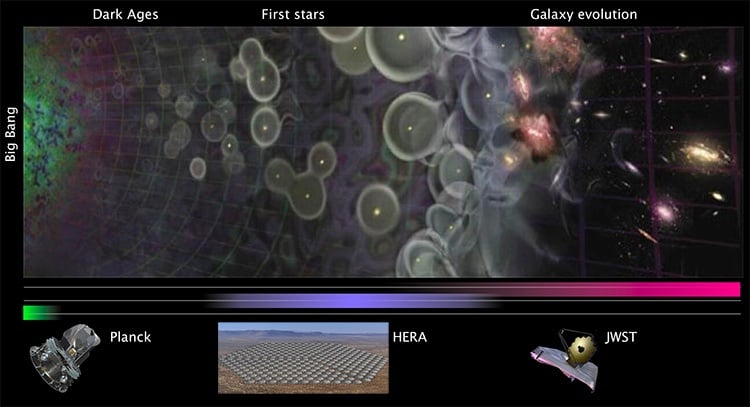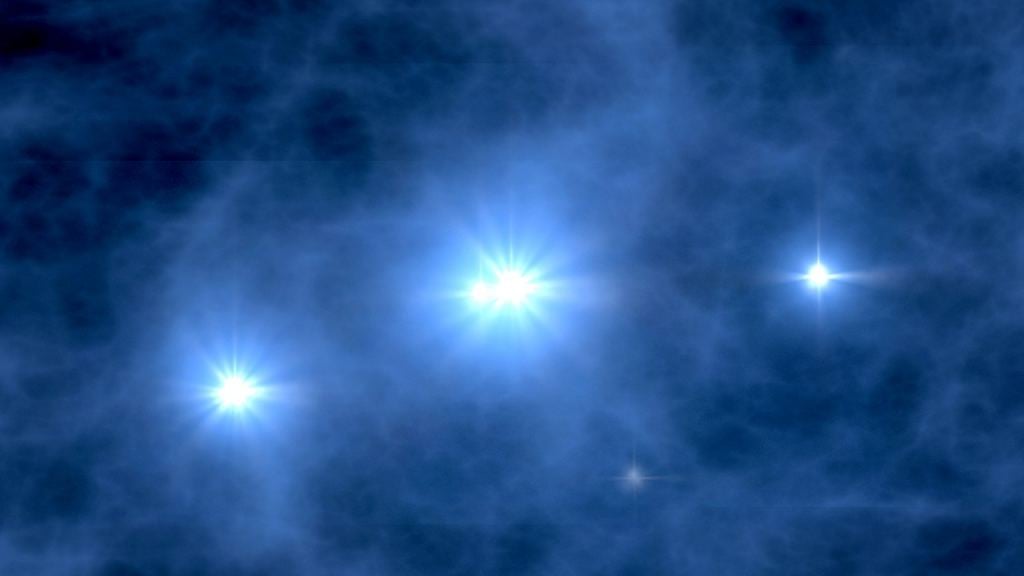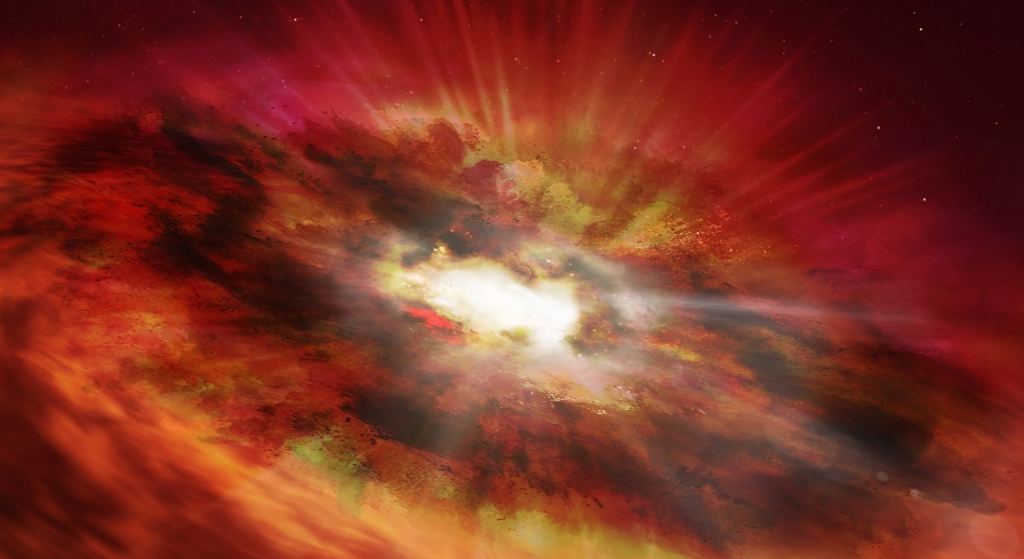The frontiers of astronomy are being pushed regularly these days thanks to next-generation telescopes and scientific collaborations. Even so, astronomers are still waiting to peel back the veil of the cosmic " Dark Ages," which lasted from roughly 370,000 to 1 billion years after the Big Bang, where the Universe was shrouded with light-obscuring neutral hydrogen. The first stars and galaxies formed during this same period (ca. 100 to 500 million years), slowly dispelling the "darkness." This period is known as the Epoch of Reionization, or as many astronomers call it: Cosmic Dawn.
By probing this period with advanced radio telescopes, astronomers will gain valuable insights into how the first galaxies formed and evolved. This is the purpose of the Hydrogen Epoch of Reionization Array (HERA), a radio telescope dedicated to observing the large-scale structure of the cosmos during and before the Epoch of Reionization located in the Karoo desert in South Africa. In a recent paper, the HERA Collaboration reports how it doubled the array's sensitivity and how their observations will lead to the first 3D map of Cosmic Dawn.
The HERA Collaboration is an international consortium comprised of astronomers and astrophysicists from South Africa, Australia, the U.S., the U.K., Israel, Italy, and India. The research was led by Joshua Dillon, a research scientist at UC Berkeley's Department of Astronomy and the lead author of the paper. The paper that describes their research and findings recently appeared online and has been accepted for publication by the *Astrophysical Journal*. Their results provide new insight into how reionization occurred in the early Universe.
From Dark to Dawn
Based on current cosmological models, the Universe began 13.8 billion years ago with the Big Bang, which produced a flurry of energy and elementary particles that slowly cooled to create the first protons and electrons (which combined to form the first hydrogen and helium atoms). The leftover "relic radiation" is observable today in the form of the Cosmic Microwave Background (CMB). Thanks to missions like the COBE, WMAP, and Planck, astronomers have mapped the faint variations in temperature that existed 380,000 years after the Big Bang.
Meanwhile, thanks to missions like Hubble, astronomers have observed galaxies as they existed roughly 1 billion years after the Big Bang (ca. 13 billion years ago). This has led to a greater understanding of how galaxies evolved and the possible role of Dark Matter and Dark Energy in the process. However, there is a gap between these observations of the CMB and early galaxies: the aforementioned "Dark Ages" (ca. 370,000 to 1 billion years after the Big Bang). This epoch cannot be studied with conventional telescopes because photons in this period were either part of the CMB or those released by neutral hydrogen atoms - the 21-centimeter hydrogen line.
As the first stars and galaxies gradually formed, the intense radiation they emitted reionized much of the surrounding Universe. This led to the Epoch of Reionization, where neutral hydrogen began to form clouds of plasma of free electrons and protons. To map these bubbles, HERA and other sophisticated radio telescopes were created to observe the hydrogen line (which has a frequency of 1,420 megahertz). This wavelength of light is one that neutral hydrogen absorbs and emits, but ionized hydrogen does not.
Since the Epoch of Reionization, this radiation has been redshifted by the expansion of the Universe to a wavelength of about 2 meters (6 feet). HERA's simple antennas, built from chicken wire, PVC pipe, and telephone poles, are 14 meters (46 feet) in diameter, allowing them to focus this radiation onto detectors. The backend is where things get sophisticated, consisting of a supercomputer and machine learning algorithms performing advanced data analysis. This map could track galactic evolution from the very early Universe to today.
Latest Analysis
The team's results showed that the earliest stars, which may have formed around 200 million years after the Big Bang, contained few other elements than hydrogen and helium. The finding is consistent with accepted models of stellar evolution, which state that metals (from lithium to uranium) formed within the first generation of stars. When these stars collapsed after a comparatively short lifespan (hundreds of millions of years rather than billions), these metals were shed with the stars' outer layers, seeding the Universe with metals that became part of subsequent generations of stars.
Astronomers are interested in the atomic composition of these early stars since this would show how long they took to heat the intergalactic medium (IGM) and cause reionization to occur. A key element here is high-energy radiation (primarily X-rays) produced by binary stars once one of them goes supernova, collapsing into a black hole or neutron star and eventually consuming their companion. Since the earliest stars had very few heavy elements (low metallicity), they would not have heated the surrounding region much and produced fewer X-rays.
Ultimately, the HERA Collaboration did not find the signal these bubbles would have emitted in the data. According to Aaron Parsons, the principal investigator for HERA, an associate professor of astronomy at UC Berkeley, and the director of its Radio Astronomy Laboratory, this rules out some theories of how stars evolved in the early Universe. "Early galaxies have to have been significantly different than the galaxies that we observe today for us not to have seen a signal," he said. "In particular, their X-ray characteristics have to have changed. Otherwise, we would have detected the signal we're looking for."
The absence of the signal largely rules out the "Cold Reionization" theory, which posits that reionization had a colder starting point. Instead, the HERA researchers suspect that the X-rays from binary stars heated the intergalactic medium (IGM) first. Said Joshua Dillon, a research scientist at UC Berkeley's Department of Astronomy and lead author of the paper:
"Our results require that even before reionization and by as late as 450 million years after the Big Bang, the gas between galaxies must have been heated by X-rays. These likely came from binary systems where one star loses mass to a companion black hole. Our results show that if that's the case, those stars must have been very low 'metallicity,' that is, very few elements other than hydrogen and helium in comparison to our sun, which makes sense because we're talking about a period in time in the Universe before most of the other elements were formed."
These findings agree with the preliminary results from the first analysis of HERA data (reported last year) that hinted that alternative theories like "Cold Reionization" were unlikely. These results were based on 18 nights of observation by Phase I of the HERA project (about 40 antennas) and were the most sensitive observations of the early Universe to date. This latest is based on 94 nights of Phase I observations (between 2017 and 2018) and demonstrates how the HERA team has improved the array's sensitivity.
This includes a 2.1-factor increase for light emitted about 650 million years after the Big Bang (a redshift value (z) of 7.9) and a 2.6-factor increase for radiation emitted about 450 million years after the Big Bang (z =10.4). This represents a great step forward for the project and astronomers' understanding of the early Universe. According to Eloy de Lera Acedo, an astrophysicist from the University of Cambridge's Cavendish Astrophysics, these latest observations are the "best evidence we have of heating of the intergalactic medium by early galaxies."
Looking Ahead
The HERA team continues to improve the telescope's calibration and data analysis in the hopes of seeing the predicted ionization bubbles in the early Universe. Filtering out the local radio noise to see the radiation of the early Universe remains a challenge since the radio emissions from this era are about one-millionth the intensity of radio noise in the vicinity of Earth. When all of HERA's radio dishes are online and fully calibrated, the team hopes to construct a 3D map of the ionized and neutral hydrogen bubbles from ca. 200 million to 1 billion years after the Big Bang.
Once that is complete, the HERA Collaboration and other astronomers expect to see a "Swiss-cheese" pattern in the early Universe, where galaxies make holes in a neutral hydrogen background. Said Dillion:
"This is moving toward a potentially revolutionary technique in cosmology. Once you can get down to the sensitivity you need, there's so much information in the data. A 3D map of most of the luminous matter in the universe is the goal for the next 50 years or more. What we've done is we've said the cheese must be warmer than if nothing had happened. If the cheese were really cold, it turns out it would be easier to observe that patchiness than if the cheese were warm."
Other cutting-edge telescopes are allowing astronomers to peer into the early Universe. This includes the Canadian Hydrogen Intensity Mapping Experiment (CHIME) in British Columbia, which is also observing the 21-cm hydrogen line to study how the Universe evolved. There's also the *James Webb Space Telescope* (JWST), which observed a galaxy that existed about 325 million years after the Big Bang this past summer. This established a new record for the earliest galaxy ever observed. However, the JWST can only observe the brightest galaxies from this epoch, while arrays like HERA and CHIME continue to probe the "darker" regions of the early Universe.
"HERA is continuing to improve and set better and better limits," said Parsons. "The fact that we're able to keep pushing through, and we have new techniques that are continuing to bear fruit for our telescope, is great."
Further Reading: University of Berkeley*, arXiv*
 Universe Today
Universe Today




